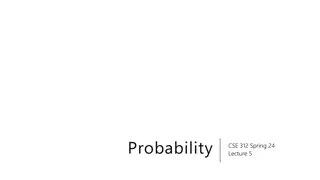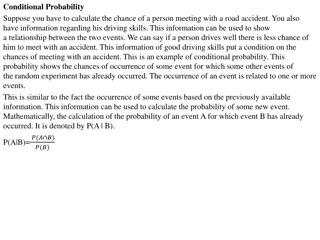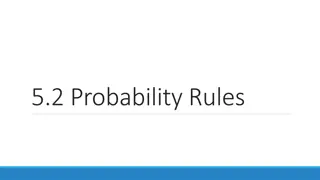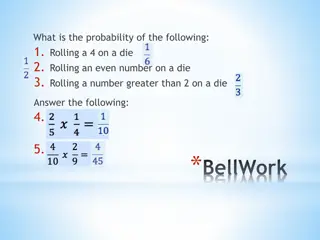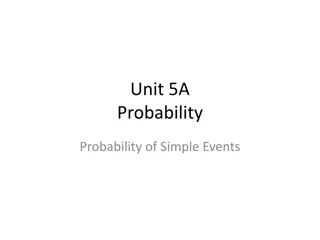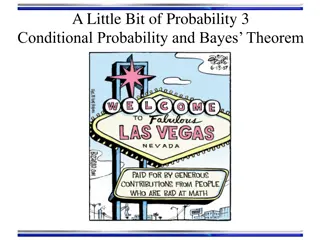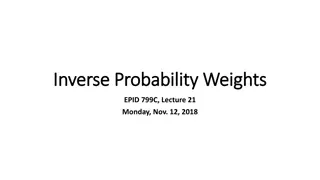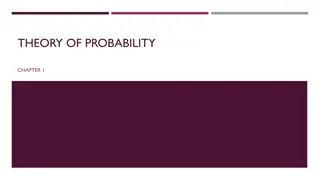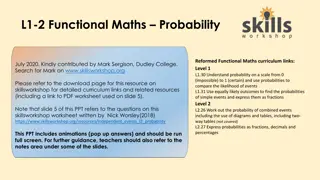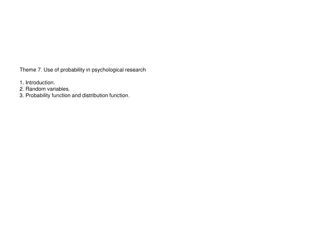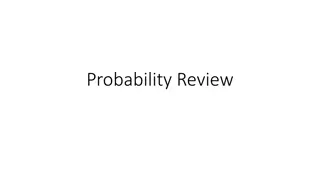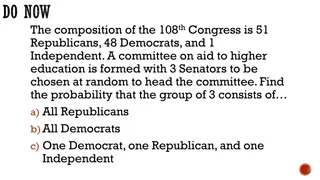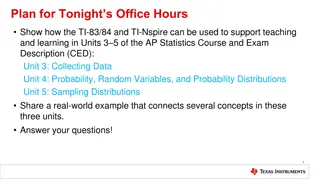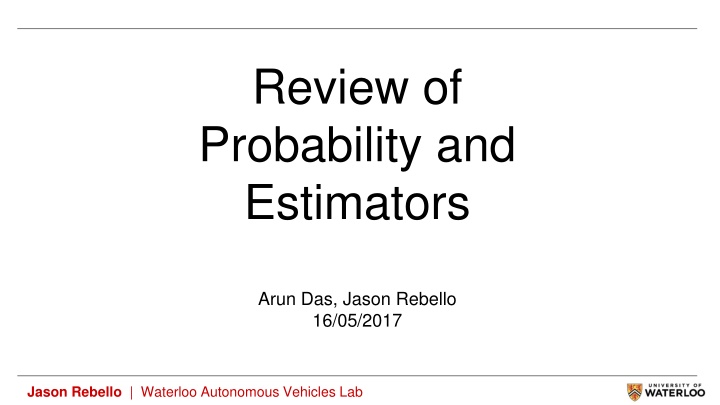
Probability, Estimators, and Random Variables in Robotics
Explore the significance of probability in robotics, from fusing sensory data to modeling states of robots and their environments using random variables. Learn about probability axioms, random variable concepts, expected value, and variance in this informative review.
Uploaded on | 0 Views
Download Presentation

Please find below an Image/Link to download the presentation.
The content on the website is provided AS IS for your information and personal use only. It may not be sold, licensed, or shared on other websites without obtaining consent from the author. If you encounter any issues during the download, it is possible that the publisher has removed the file from their server.
You are allowed to download the files provided on this website for personal or commercial use, subject to the condition that they are used lawfully. All files are the property of their respective owners.
The content on the website is provided AS IS for your information and personal use only. It may not be sold, licensed, or shared on other websites without obtaining consent from the author.
E N D
Presentation Transcript
Review of Probability and Estimators Arun Das, Jason Rebello 16/05/2017 Jason Rebello | Waterloo Autonomous Vehicles Lab
Probability Review | Why is probability used in Robotics ? - State of robot (position, velocity ) and state of its environment are unknown and only noisy sensors available (GPS, IMU) - Probability helps to fuse sensory information - Provides a distribution over possible states of the robot and environment Jason Rebello | Waterloo Autonomous Vehicles Lab
Probability Axioms | Probability for any event A in the set of all possible outcomes. Probability over the set of all possible outcomes Probability of the Union of events If the events are mutually exclusive Jason Rebello | Waterloo Autonomous Vehicles Lab
Random Variables | Random Variable assigns a value to each possible outcome of a probabilistic experiment. Example: Toss 2 dice: random Variable X is the sum of the numbers on the dice Discrete Continuous - Distinct Values - Any value in some interval - Probability Mass function - Probability Density function - Eg: X = (1) Heads, (0) Tails Y = Year a random student was born (2000,2001,2002,..) - Eg: Weight of random animal Jason Rebello | Waterloo Autonomous Vehicles Lab
Random Variables | Expected Value It is the long-run average value of repetitions of the experiment it represents. Expectation is the probability weighted average of all possible values. E[X] = xx * P(x) Eg. For a dice. E(X) = ( )*1 + ( )*2 + ( )*3 + ( )*4 + ( )*5 + ( )*6 = 3.5 Properties: 1) E[c] = c where c is a constant 1) E[X+Y] = E[X] + E[Y] and E[aX] = aE[X] .. Expected value operator is linear 1) E[X | Y=y] = xx * P(X=x | Y=y) Conditional Expectation 1) E[X] E[Y] if X Y Inequality condition Jason Rebello | Waterloo Autonomous Vehicles Lab
Random Variables | Variance Variance measures the dispersion around the mean value. Var[X] = ?2= E [ X- ? ]2 Var[X] = E[ X2] - E[ X ]2 Eg: For a dice. E[ X2] = ( )*12 + ( )*22 + ( )*32 + ( )*42 + ( )*52 + ( )*62= 91/6 E[ X ] = 7/2 Var[X] = (91/6) - (7/2)2= 2.9166667 Properties: 1) Var[ aX+b ] = a2Var[X] .. Variance is not linear 1) Var[X+Y] = Var[X] + Var[Y] .. If X and Y are independent Jason Rebello | Waterloo Autonomous Vehicles Lab
Joint and Conditional Probability | Joint Probability Joint Probability of Independent random variables Conditional Probability Conditional Probability of Independent random variables Jason Rebello | Waterloo Autonomous Vehicles Lab
Mutually Exclusive, Independent Events | What is the difference between Mutually exclusive events and Independent Events ? Jason Rebello | Waterloo Autonomous Vehicles Lab
Mutually Exclusive, Independent Events | - Events are mutually exclusive if the occurrence of one event excludes the occurrence of other events. Eg Tossing a coin. The result can either be heads or tails but not both P(A U B) = P(A) + P(B) P(A,B) = 0 - Events are independent if the occurrence of one event does not influence the occurrence of the other event. Eg Tossing two coins. The result of first flip does not affect the result of the second P(A U B) = P(A) + P(B) - P(A)*P(B) P(A,B) = P(A)*P(B) Jason Rebello | Waterloo Autonomous Vehicles Lab
Law of Total Probability and Marginals | Jason Rebello | Waterloo Autonomous Vehicles Lab
Probability Example | - Calculate Marginal Probability of person being hit by car without paying attention to traffic light ? - Assume P(L=red) = 0.2, P(L=yellow)=0.1, P(L=green)=0.7 - P(hit | colour)+P(not hit | colour) = 1 - P(hit, L=red) = P(hit | L=red) * P(L=red) = 0.01*0.2 = 0.002 - colourP(hit) = colourP(hit,all colour) = colourP(hit | any colour) * P(any colour) = P(hit | red) * P(red) + P(hit | yellow) * P(yellow)+ P(hit | green) * P(green) = 0.01*0.2 + 0.1*0.1 + 0.8*0.7 = 0.572 Jason Rebello | Waterloo Autonomous Vehicles Lab
Parameter Inference | Experiment: We flip a coin 10 times and have the following outcome. What is the Probability that the next coin flip is T ? 0.3 0.38 0.5 0.76 Jason Rebello | Waterloo Autonomous Vehicles Lab
Parameter Inference | Why is 0.3 a good estimate Every flip is random. So every sequence of flips is random. We have a parameter that tells us if the next flip is going to be tails. The sequence is modeled by the parameters ?1, .. ?10 Find ?i s such that the above probability is as high as possible. Maximize the likelihood of our observation (Maximum Likelihood) Jason Rebello | Waterloo Autonomous Vehicles Lab
Parameter Inference | Assumptions Assumption 1 (Independence): The coin flips do not affect each other Assumption 2 (Identically Distributed): The coin flips are qualitatively the same Independent and Identically Distributed : Each random variable has the same probability distribution as others and all are mutually independent Jason Rebello | Waterloo Autonomous Vehicles Lab
Parameter Inference | Find critical point of the above function. Monotonic functions preserve critical points. Use log to make things simpler argmax?ln [ ?3(1-?)7] = argmax?|T| ln ? + |H| ln (1-?) Taking the derivative and equating to 0. = 3/10 = 0.3 This justifies the answer of 0.3 to the original question. Jason Rebello | Waterloo Autonomous Vehicles Lab
Parameter Inference | Maximum Likelihood Estimation Suppose there is a sample ?1.. ?nof n independent and identically distributed observations coming from a distribution with an unknown probability density function. Joint Density Function: Consider the observed values to be fixed parameters and allow ? to vary freely Likelihood: More convenient to work with natural log of the likelihood function Log-Likelihood: Average Log-Likelihood: Maximum Likelihood Estimator: Jason Rebello | Waterloo Autonomous Vehicles Lab
Parameter Inference | Problems with MLE Let s assume we tossed the coin twice and got the following sequence The probability of seeing a tails in the next toss is Since no tails observed ?MLE= 0 MLE is a point estimator and is prone to Overfitting. How do we solve this ? Assume a prior on ? Jason Rebello | Waterloo Autonomous Vehicles Lab
Parameter Inference | Bayes Rule Bayes Rule : Likelihood : Prior : Evidence : Posterior Jason Rebello | Waterloo Autonomous Vehicles Lab
Parameter Inference | Choosing the Prior Choosing the Prior (a-1) and (b-1) are the number of T and H we think we would see, if we made (a+b-2) many coin flips a = 1.0 a = 2.0 b = 1.0 b = 3.0 a = 8.0 a = 0.1 b = 4.0 Jason Rebello | Waterloo Autonomous Vehicles Lab b = 0.1
Parameter Inference | Maximum - A - Posteriori Evidence Likelihood Prior Maximum A Posteriori Estimation Jason Rebello | Waterloo Autonomous Vehicles Lab
Homework | Determine the Maximum Likelihood Estimator for the mean and variance of a Gaussian Distribution Jason Rebello | Waterloo Autonomous Vehicles Lab

